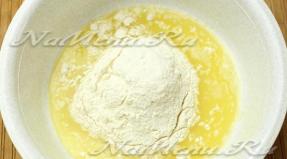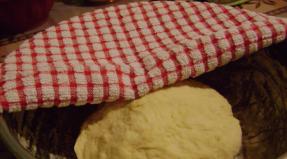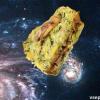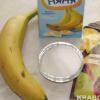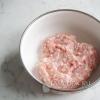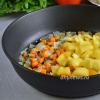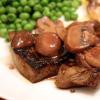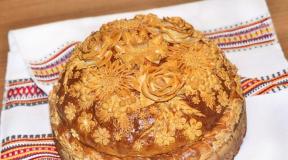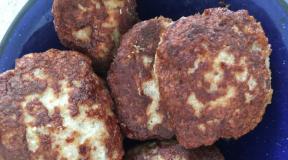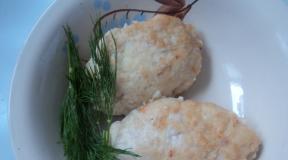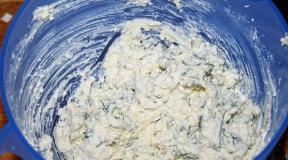Poultry-shaped pastries. How to make larks out of a different dough
There is such a custom at the beginning of spring, on the day of the vernal equinox, to bake buns in the form larks or other birds. Dough larks symbolize the arrival of spring, according to popular beliefs, they carry spring and warmth on their wings. Usually larks baked from unleavened dough, they can be different shapes and size. I baked my larks from butter yeast dough... They turned out to be lush, ruddy and very tasty. This recipe has nothing to do with religious practices. If you are fasting, bake lean buns.
Ingredients
To make dough larks you will need:
1 glass of milk;
2 tbsp. l. Sahara;
a pinch of salt;
1 tsp dry yeast;
50 g butter;
3 cups flour;
a few raisins.
For syrup:
2 tbsp. l. Sahara;
2 tbsp. l. water.
Cooking steps







Grease baking tray vegetable oil, put the dough larks on it. Use scissors to make small cuts around the edges to form the wings. Lubricate every bird sweet water with a brush. For cooking sweet water dissolve sugar in hot water and cool.

Place the baking sheet in the oven at 190 degrees for 20-25 minutes. Grease hot buns again with sweet water. Transfer to a wire rack and cool.


 Bon appetit, please your loved ones!
Bon appetit, please your loved ones!
They entered the life of Orthodox Christians. One of them - the oven "larks" - delicious buns in the form of birds to mark the beginning of spring and the return of birds from warm countries.
In the view of our ancestors, the Slavs, feathered guests brought spring from there on their wings. The real spring usually began with the arrival of larks - these good messengers of the sun.
In Russia, there was no single day or week for the holiday of the meeting of spring. In each locality, this date was determined by folk signs.
In the old days, such buns were baked to commemorate the "forty martyrs" (40 Roman Christian soldiers tortured in the 4th century for refusing to worship pagan gods) - March 9 according to the church calendar (March 22 new style).
What an affectionate and life-affirming holiday it is when all nature is revived and joyful and kind spring troubles come.
The holiday of meeting spring falls on the time of Great Lent, therefore, for believers, larks are baked only from lean dough... And the rest can indulge in spring buns.
About cooking butter dough see in the section on the page:

"Larks" at proofing.
These Larks are made in Method 1 (see "Larks - Method 1" below).
The "wings" are molded separately.
NOTE:
*
- according to recipes marked with an asterisk, you can cook on fast days.
Dissolve yeast in warm water, add flour, sugar, vegetable oil, vanillin, a little carrot juice for color and knead the dough (it should be denser than regular lean dough).
Let it rise, then roll out on a floured surface and cut into strips 15 cm long and 2 cm wide.
Tie each strip with a knot so that a "bird's head" is formed on top.
Stick 2 raisins on it - "eyes", at the end of the strip - "tail" - draw several shallow lines with a knife.
Sprinkle the larks with sugar and bake in the oven.
You can also shape the symbolizing warmth - "the sun": roll the pieces of dough in the form of a circle, stick "rays", and make "eyes" and "mouth" from the raisins.
Ingredients:
3 cups flour, 125 g milk, 10 g yeast, 15 g butter, 1 egg, 2 tbsp. tablespoons of sugar, salt, 1 tbsp. a spoonful of vegetable oil.
Prepare a yeast dough with the indicated ingredients and mold it into larks like a lean dough.
Grease them with an egg on top and bake in the oven.
Ingredients:
3-3.5 cups of flour, 1-2 eggs, 1 cup of sugar, 1 cup of kefir or yogurt, 1/2 pack of butter, 1 teaspoon of baking soda, vinegar.
Grind eggs white with sugar, pour in kefir or yogurt, put soda quenched with vinegar, melted butter, flour and knead the dough.
Let it stand for 10-15 minutes, then shape the skylarks like lean dough, grease with an egg and bake in the oven.
NOTE.
Lot different types for butter dough, see section i.
How to sculpt and decorate holiday curly baked goods, see the page and the links on this page.
The decoration of the larks can be different.

Moscow larks (see below "Larks - 2nd method").

Arkhangelsk Larks.

Larks Nekrasov.

Ural larks.

Ryazan larks.

Ryazan larks.

Tula larks.

Easter larks(see below "Larks - 1st method").

Tula gift lark (rather, it's a whole firebird).
There are many ways to sculpt larks. We will show a few.
So the first way. We make a long sausage out of the dough and fold it into a knot.

Flatten one end and cut. We stretch the other end a little, form the head and beak.

Now we make eyes. To do this, cut the zest into pieces. It is more convenient to attach the eyes with a toothpick. We put the zest on a toothpick and press it into the dough.
Transfer the finished birds to a greased baking sheet.
Before putting them in the oven, the larks need to be allowed a little distance.
We place the birds in a preheated oven.

Ready Larks:

We make a short thick sausage. On the one hand, we form the head and beak. We squeeze the other side. This will be the tail and wing.

Cut the flattened side in half. We make "feathers" with a knife.

Bend the wing up. We make an eye.
You can brush your skylark with a loose egg or yolk before baking. Or sometimes smeared with sour cream.

Ready-made lark, oiled for shine after baking with vegetable oil:

We make a medium-length sausage. We bend it into a loop.

We flatten the ends of the sausage and cut them - these are the wings.
On the other hand, we form the head and beak.
Making eyes.

We make two sausages and lay them crosswise.

Flatten both ends of the upper sausage and one end of the lower sausage.
Raise the other end of the lower sausage and form the head and beak.

We cut the tail and wings, make eyes.
The Suffering of the Saints 40 Martyrs of Sebastia
In reverence for the memory of the holy 40 martyrs, which is always celebrated on the Forty Day, the Orthodox Church decided to celebrate the Liturgy on the day of their repose, to facilitate fasting and thus make this day more solemn. According to custom, larks are baked on this day.
Many very ancient pagan customs entered the life of Orthodox Christians. One of them is the Larks oven - delicious bird-shaped buns to celebrate the beginning of spring and the return of birds from warm countries.
In the view of our ancestors, the Slavs, feathered guests brought spring from there on their wings. The real spring usually began with the arrival of larks - these good messengers of the sun.
In the old days, such buns were baked to commemorate the "forty martyrs" (40 Roman Christian soldiers tortured in the 4th century for refusing to worship pagan gods) - March 9 according to the church calendar (March 22 new style).
What an affectionate and life-affirming holiday it is when all nature is revived and joyful and kind spring troubles come.
The holiday of meeting spring falls on the time of Great Lent, therefore, for believers, larks are baked only from lean dough. And the rest can indulge in spring buns.
"Larks" at proofing.
These Larks are made in Method 1 (see "Larks - Method 1" below).
The "wings" are molded separately.
NOTE:
* - according to recipes marked with an asterisk, you can cook on fast days.
* Lean larks
Dissolve the yeast in warm water, add flour, sugar, vegetable oil, vanillin, a little carrot juice for color and knead the dough (it should be denser than regular lean dough).
Let it rise, then roll out on a floured surface and cut into strips 15 cm long and 2 cm wide.
Tie each strip with a knot so that a "bird's head" is formed on top.
Stick 2 raisins on it - "eyes", at the end of the strip - "tail" - draw several shallow lines with a knife.
Sprinkle the larks with sugar and bake in the oven.
You can also shape the symbolizing warmth - "the sun": roll the pieces of dough in the form of a circle, stick "rays", and make "eyes" and "mouth" from the raisins.
Butter larks
Ingredients:
3 cups flour, 125 g milk, 10 g yeast, 15 g butter, 1 egg, 2 tbsp. tablespoons of sugar, salt, 1 tbsp. a spoonful of vegetable oil.
Preparation
Prepare a yeast dough with the indicated ingredients and mold it into larks like a lean dough.
Grease them with an egg on top and bake in the oven.
Holiday larks
Ingredients:
3-3.5 cups of flour, 1-2 eggs, 1 cup of sugar, 1 cup of kefir or yogurt, 1/2 pack of butter, 1 teaspoon of baking soda, vinegar.
Preparation
Grind eggs white with sugar, pour in kefir or yogurt, put soda quenched with vinegar, melted butter, flour and knead the dough.
Let it stand for 10-15 minutes, then shape the skylarks like lean dough, grease with an egg and bake in the oven.
The decoration of the larks can be different.

Moscow larks (see below "Larks - 2nd method").

Arkhangelsk Larks.

Larks Nekrasov.

Ural larks.

Ryazan larks.

Ryazan larks.

Tula larks.

Easter Larks (see "Larks - Method 1" below).

Larks on an Easter wreath.

Cookies "Larks" made from gingerbread or flavored shortcrust pastry made with a mold.

Tula gift lark (rather, it's a whole firebird).
Larks - 1st method
So the first way. We make a long sausage out of the dough and fold it into a knot.

Flatten one end and cut. We stretch the other end a little, form the head and beak.

Now we make eyes. To do this, cut the zest into pieces. It is more convenient to attach the eyes with a toothpick. We put the zest on a toothpick and press it into the dough.
Transfer the finished birds to a greased baking sheet.
Before putting them in the oven, the larks need to be allowed a little distance.
We place the birds in a preheated oven.

Ready Larks:

Larks - 2nd way
We make a short thick sausage. On the one hand, we form the head and beak. We squeeze the other side. This will be the tail and the wing

Cut the flattened side in half. We make "feathers" with a knife.

Bend the wing up. We make an eye.
You can brush your skylark with a loose egg or yolk before baking. Or sometimes smeared with sour cream.

Ready-made lark, oiled for shine after baking with vegetable oil

Larks - 3rd way
We make a medium-length sausage. We bend it into a loop.

We flatten the ends of the sausage and cut them - these are the wings.
On the other hand, we form the head and beak.
Making eyes.

Larks - 4th method
We make two sausages and lay them crosswise.

Flatten both ends of the upper sausage and one end of the lower sausage.
Raise the other end of the lower sausage and form the head and beak.

We cut the tail and wings, make eyes.

Ready-made larks can be greased with vegetable oil:

According to a long tradition in home cooking larks are attended by children.

Method for children's creativity:
Simple traditional skylark design
tying dough flagella in a knot




Previously, in peasant families, children and always livestock were treated to larks.
Larks can be decorated with candied fruits.

Smaller children can be given already fashioned larks, so that they "straighten" them a little to their liking.

Small children will cope with making koloboks.

Koloboks are made quite simply:
Cut the dough roller into pieces, roll them into balls, put on a greased metal sheet (baking sheet), allow time for proofing, and then brush with strong sweet tea with a brush, then after baking the balls will have a smooth, shiny, golden surface (kolobans gold).
The results of children's creativity:

Hear how a real lark sings:
This wonderful melody by Ariel Ramirez (Argentina) performed by Paul Mauriat's orchestra is probably known to everyone.
But did you know that this beautiful music is called "Lark" ("Alouette")!
Information for the home cook
"Yeast" from beer. Mix 1 glass of flour with 1 glass of warm water and leave for 5-6 hours. Then add 1 glass of beer, 1 tbsp. spoon of sugar, stir well and put in a warm place.
The resulting mass is put into the dough like ordinary yeast.
This "yeast" keeps well in a cold place.

Holiday of the Lark
22 march
Holiday of the arrival of spring
After the introduction of Christianity in Russia, the feast of the Lark was "shifted" by the churchmen 1 day later than the day of the vernal equinox (to coincide with the Christian feast of the forty martyrs, which is celebrated on March 22).
The vernal equinox is the beginning of an astronomical spring on the planet. According to the modern calendar, the day of the vernal equinox is different years falls on March 20 or 21 - see the table
According to the ancient solar calendar of our ancestors, which also had 12 months, the days of the spring and autumn equinoxes, the days of the summer and winter solstices were the first days of the months. These days, our ancestors celebrated 4 great solar holidays - 3 two-week and 1 (summer solstice) one-day, because the miserable summer season did not allow to celebrate for a long time.
The solar calendar has always been accurate because its linking to four annual astronomical events excluded the appearance and accumulation of errors.
The number of days in this calendar, as in the modern Gregorian, could be different in different years.
In ancient times, the Vernal Equinox Day was the Slavic New Year, the middle, the most important holiday of Komoeditsa, a 2-week spring great solar holiday of our ancient Slavic ancestors and most other ancient peoples of Eurasia and North Africa.

Slavic pagan temple. Eve of the holiday of Komoeditsa.
The weak baby sun Kolyada, which is reborn annually renewed in the morning after the mysterious and magical Night of the Winter Solstice (the longest night of the year), having passed through Winter and gaining strength to rise higher in the sky, on the festive Spring Equinox Day becomes a strong youth Yarila, melts the snow , drives away the annoying Winter, and the long-awaited Spring comes for all nature.
On this day, an astronomical spring begins on the planet.
The ancient Slavic holiday Larks is celebrated on March 22 - the day of the vernal equinox, which was celebrated with the celebration of the pagan Komoeditsa. It was believed that on this day larks return to their homeland, and other migratory birds fly after them.
Upon arrival of the larks, they determined when to plow and start other spring work. Once the lark has arrived, it means that spring has come.
The lark's song is soft and pleasant. The flight of the lark is peculiar: the bird first rises up and then falls down, and the song changes accordingly. "The lark plows the sky" - they say among the people.
On Zhavoronkov, in villages, and sometimes in cities, rituals with obvious pagan roots were performed: early in the morning, the hostesses baked birds from dough, round gingerbread and koloboks. Then they made small nests of straw, put the balls in them and put them in the poultry house - it was believed that this would help the chickens to carry better and not get sick.
It was customary to treat everyone with round gingerbread, including livestock. The first larks were always taken to the barn and chicken coop, where they were treated to their animals and birds so that they would gain strength after a long winter.
In some localities, an additional 40 larks were baked, which had to be distributed to passers-by.
On Soroki, "larks" are baked from sour dough (in some places "sandpipers", "sparrows" or "nuts") from different flours, in most cases with outstretched wings, as if flying, and with tufts, as well as birds on nests. Nests with testicles are also made of dough.
In addition to larks, unleavened dough is baked big pancakes and dry well; they are called "sweet food".
In the Kashirsky district of the Voronezh region, pancakes, pancakes and crumpets from butter dough were baked. Donuts were made like magpies, tail up or like a cross, and put money inside for luck.
Drinks for larks and other baked goods: bread kvass, compotes, jelly, berry fruit drinks and shoot it down.


Children are willingly allowed to make "larks". When the larks are ready, several birds are planted on the windowsill and the window is opened.
The birds were handed out to children, and those with shouts and ringing laughter ran to call out to the larks, and with them spring. For this baked larks attached to long sticks and ran out with them on the hills or put the birds on the fence and, huddled in a bunch, they shouted:
Larks, come fly!
Drive the cold winter away!
Bring warmth in the spring!
We are tired of winter
I ate all the bread with us!
They said: “Spring is red, where did it come? - On a plow, on a harrow, on an oat sheaf, on a rye stack. With "sandpipers" they tumbled on the straw and said: "Sandpipers-larks, fly at odonushki, peck a plow, choose a cockle."
Climbing onto a barn, a fence, or throwing up cookies, the children called out for spring: “Little sun, little bucket, look out the window. Sunny, dress up, Red, show yourself! Send us, Lord, a warm summer, a fruitful year and more light! "
The rite of spring clicking was accompanied by special ritual songs - vesnianki:
You are a binge, a binge, a lark,
Sing your song, ringing song!
Sing it, sing it, little bird,
Little bird, vociferous,
Whether about the warm side,
What about those about the land about the overseas,
Foreign lands overseas,
Where the dawn converges with the dawn,
Where the red sun does not set
Where the heat will never stop!
You binge - binge, lark,
Lark you are a guest of spring
About life, about other things!
In round gingerbread, and somewhere in larks with folded wings, they hid various little things in order to guess by them. Whoever gets the ring will get married or get married, whoever gets a penny will earn good money this year, and whoever has a small rag tied in a knot will have a child.
However, in addition to good omens, it was imperative to blind larks with sad predictions, and empty larks - otherwise the good ones would not come true. The first eaten lark was considered significant, important. Of course, the hostesses were cunning in their own way and gave the "unlucky" birds to the kids with a strict order - not to eat, but to leave them on a pole in the field, or push them deeper under the "safe" birds.
An eyewitness to this holiday in the Gomel district in the 1880s, ethnographer Z. Radchenko recalled:
“Girls gather in the evening at the end of their work and become groups on the banks of the river, and if there is no river or lake, then outside the village, on the site, sometimes on the hill. These groups are established at a distant distance from one another; when one group finishes its verse and its last note just fades away, then in the distance another group continues its verse. "
The ethnographer further notes:
“Vesnyanki differ from all other songs in their chorus, like a sound (in the middle of the song), which sounds very beautiful when the song is heard in the forest, sweeps over the spring flood and echoes in a distant echo. Doesn't this indicate a very ancient origin of the stoneflies? "
The Christian tradition brought to Russia did not completely replace the pagan larks, but in a bizarre way intertwined with them.
The holiday of the Lark began to be called the "Magpies" as well. Not in honor of the white-sided corvids, but in honor of the forty martyrs of Sebaste. These were Christian soldiers who were martyred for their faith, their memory is celebrated on March 22.
Larks had nothing to do with the warriors, but the number forty firmly rooted in the holiday:
"The lark brought forty birds with him."
Other names of the holiday
Magpies, Forty forties, Saints Magpies, "Sorochini" (Ukrainian), Equinox, Larks, Name day of the lark, Kuliki, Black day (Kargopol.), Calls of Spring, "Gukanne Viasny" (Belarusian), "Babies" (Serb. ) - Young or newlyweds, "Zmijin Dan" (Serb.) - Snake Day, Forty Martyrs.

Komoeditsa - Russian New Year
Day of spring equinox
The beginning of an astronomical spring on the planet
Today is Russian New Year!
Today - the Sun comes to us!
Winter creeps helplessly away
Spring reigns from now on!
Today - New Life Feast!
Today is the Feast of Awakening!
From holes, crevices, den and holes
Everything climbs to the Light of Renaissance!
Today it is bubbling and seething,
All Living sings and dances!
Today - our God ROD commands
Wear at least something Rdyanoe.
The Color of Life is a RELATED Color!
He is alien to the poor and humble!
Who is in black today - oppression of the ridge
Under the yoke of "good" and "sacred" ...
May the "New Year" be with us in winter,
Let a stranger god to us become a jail -
We are not crushed by darkness,
All the same Komoedice to be Russian !!!
Notes.
Rod - leading its history since the Paleolithic era, a very ancient supreme pagan God of the peoples of Eurasia (including the Slavs), the all-embracing and all-uniting Holy Spirit, having no visible appearance (something like a physical gravitational or electromagnetic field); much later, on the basis of this very ancient pagan God, the concept of the hypostasis of the Christian God - the Holy Spirit, as well as the Muslim Allah (see Dictionary of Russian pagan gods) arose.
New Year- Slavic New Year began on the day of the vernal equinox.
According to a fairy tale, on this day of the arrival on the planet of Spring, the Snow Maiden, a magical creature, melted winter cold and snow (see the Story of the Snow Maiden and the Story of Santa Claus, as well as the great sunny holiday Yule-Solstice).
Sayings and signs on Larks
* How many thawed patches, so many larks.
* If snow falls on this day, then Holy Easter week will be cold, if it is dry, then do not expect rain on Easter either.
* On Magpies, day and night are measured. Winter ends, spring begins.
* Come, sandpiper, from across the sea, bring Spring out of captivity!
* A sandpiper flew in from overseas, brought the spring out of the gate.
* A sandpiper flew in from overseas, brought water from captivity.
* It is far from the sandpiper to Petrov's day.
* Arrival of mallards (mallard ducks) and sandpipers - for an early warmth.
* Forty martyrs, forty birds fly.
* Forty birdies make their way to Russia.
* Holy magpies - golden kolobans (buns).
* A crane on its tail brought an icebreaker wagtail.
* I saw a starling - know: spring is at the porch.
* Crane brings the sun.
* If a titmouse sings on a Magpie, it spells warmth.
* The lark comes to the warmth (to the grass), the finch - to the cold, to the frost.
* Early arrival of cranes - by early spring.
* The crane will fly to the crust - to crop failure.
* The crane flew in - and brought warmth, it will melt in the swamp.
* The cranes fly low, quickly, silently - wait for an imminent storm.
* Early swallows - for a happy, productive year.
* Sinka (wagtail) will arrive, so after 12 days the river will come up.
* If the birds began to build nests on the sunny side, then wait for a cold summer.
Northern goats for invoking spring
on the holiday of the Lark

Kargopol Kozuli (Kargopol is a city in the Arkhangelsk region)
It's special twisted ceremonial cookies from rye dough(can also be made from wheat). They lay it out in the form of waves or loops, spirals, lattices, eights, plants, bird figurines.
Earlier, in the northern Kargopol land, spring was called with the help of such cookies. This ritual was also aimed at ensuring fertility in the new year.
Over time, the magical meaning of the ceremony associated with the meeting of spring was lost, but the custom took on new forms - twisted cookies turned into just a treat, game or fun for children.


Mezen roe.
In the Russian North, in settlements on the Mezen River, special twisted goats were baked for the holidays.
From rye flour kneaded the dough, rolled it out into thin ropes, and then laid it out on a baking sheet in the form of animal figures - horses, elk, cows, birds.
As a gift, the rogue wished good, wealth and prosperity.
V modern conditions roes are also made from wheat dough.
For the preparation of curly and painted gingerbread, see page Russian gingerbread and section Painted gingerbread and gingerbread houses.
In the Russian North, in order to invoke spring on the holiday of the Lark, in addition to buns-larks, northern curly goat cookies are baked.
Kozuli are ceremonial cookies, a type of gingerbread made from wheat or rye flour, often in the form of sheep, cows, horses or intricate patterns.
Roe deer were presented to carols and relatives, to increase their fertility they were fed to livestock, used as a talisman for barns and stables. In addition, the goats were used for fortune telling. One of the carols sounds like this: "We don't care about green wine, And we don't care about a drunken brother, And we don't care about a festive little goat."
Roesuli are prepared either from rye or wheat dough, which should be steep enough to keep the shape of the curly products well.
The northern gingerbread of the goat first appeared in the Arkhangelsk Solombala - the area of artisans.
In those distant times, goats were baked only for the largest holidays.
For a long time, it was believed that the roe deer brings good luck. For example, people believed that if a girl bakes a goat herself, and then gives it to a young man, then in next year she will definitely get married.
A large goat was given immediately for the whole family. It was believed that she would bring good luck to the house, would become his amulet.
V holidays"goats" were put on the windows of huts, they were presented to relatives and carols, especially children, in order to ensure well-being in the house, they were attached to the gates of the barnyard so that the cattle would reproduce and not get lost in the forest in the summer.
Kozuli were most often baked in an oven, but back in the 1930s, there was a more archaic method: a figurine sculpted from dough was dipped in boiling water for several minutes to brew to maintain its shape, and only then was placed in the oven.
Ingredients gingerbread dough for roe:
- 1 cup of sugar
- 1/2 glass of water
- 1 egg and 2 yolks
- 100 g butter
1/2 teaspoon salt
- 1 tablespoon of finely ground spices (cinnamon, cloves, cardamom, ginger, nutmeg)
- 0.4-0.5 kg of flour until a thick plastic consistency is obtained
Roe dough preparation:
1. Pour half of the sugar into a deep saucepan or frying pan and, stirring constantly, burn it until dark brown. A kind of "chocolate foam" should form.
2. Very carefully add boiling water to our burnt sugar.
Potholders should be worn during this procedure. A lot of hot steam will be emitted!
Attention! Don't bend over the pan, keep your face away!
The boiling water should be just steep, not just hot. And it should be poured in very small portions, otherwise you will get caramel.
4. Remove the pan from the heat. Add butter to the mixture, stir and leave to cool to room temperature.
5.Mix the egg and yolks well until smooth and add them to the cooled mixture.
6.Pour salt and spices into the mixture.
7. Sift the flour and gradually add it to the mixture, while stirring the dough well so that there are no lumps. Stir the dough with a fork or whisk as long as possible. When the thickened dough can no longer be stirred with a fork, put it on a board and stir with your hands.
8. The kneading of the roe dough is finished.
Better to close it tightly and leave to ripen in the refrigerator until tomorrow.
But if there is no time, you can leave the dough at room temperature for a while, and then put it in the freezer for 20-30 minutes.
9. The gingerbread dough is ripe.
We roll it out with a thickness of 5-7 mm and cut out the figures we like. We use various cookie cutters. If there is no suitable mold, then you can make a cardboard stencil and cut out figures from the dough with a knife on it.
For the roes shown in the photo above, roll out the dough into a layer, cut into strips, roll them into thin long flagella and lay out the patterns on a greased baking sheet.
10. Place the cut out figures on a lightly oiled baking sheet.
We bake at 210-220 gr. From 5-10 minutes depending on the size of the gingerbread.
It is very convenient to use silicone baking mats. The dough can be rolled out directly on the rug and baked on it.
Happy holiday to you!
5 105 ratings
Today is March 22nd. According to the Orthodox calendar, this is the Memorial Day of the Forty Martyrs of Sebastia. Also on this day, an old Slavic holiday was celebrated - Larks. It was believed that on this day these little songbirds flew in, and after them spring came.
We are already tired of winter, together with its cold and icy conditions, so we decided to invite a warm sunny spring and bake rich larks.
This activity is very exciting, your children will love to create their spring masterpieces with you. You can hide a ring, a money or a rag tied with a knot in some birds, and in the evening invite friends over a cup aromatic tea find out who in the near future is waiting for marriage or marriage, wealth or the birth of children.
For larks done butter dough... Don't forget what's coming Great post so the dough will be lean. By the way, I like butter dough on water and vegetable oil more than on milk and eggs.
For those who decide to bake larks according to our recipe, we will reveal our secrets of their preparation. For the dough, carbonated mineral water, so the dough rises a lot - make the larks not too large and put them on a baking sheet away from each other. To keep the birds beautiful and ruddy, brush them with a strong sweet brew before baking. After baking, you can grease the larks with vegetable oil.
Well, that's all the secrets of making larks. As you can see, there are not many of them, and the process itself is simple and fun. Let's celebrate spring with fun and deliciousness!
Ingredients:
- Flour - 0.5 kg.;
- Carbonated water - 200 ml;
- Vegetable oil - 75 grams;
- Sugar - 3 tablespoons;
- Salt - 1 teaspoon;
- Yeast - 1 sachet (11 grams);
- Strong sweet tea- 2-3 tablespoons;
- Raisins for the eyes.
How to make dough larks:
Step 1
Dissolve yeast in warm carbonated water.
Step 2
Sift flour into a deep bowl, add sugar, salt, vegetable oil, water with yeast and knead the dough.
Step 3
Cover the bowl with the dough with a clean towel and put it in a warm place for 1 hour.
Step 4
When the dough rises, knead it and make larks. We make larks like this - divide the dough by 15 equal parts, we roll each ball of dough into a tourniquet and tie it with a knot, form a head from one end of the knot, and flatten the other end and cut it in the form of a tail.

The first way to sculpt dough larks

The second method of sculpting dough larks

How to make dough larks
Step 5
Before baking, grease the larks with strong sweet tea.
Step 6
We bake larks in a preheated oven at a temperature of 220-240 degrees for 15 minutes.
Step 7
Ready-made larks can be greased with vegetable oil.
(Viewed 502 times, 1 visits today)
In the Christian calendar, March 22 is the day of commemoration of the Forty Martyrs of Sebastia. In 320, in the city of Sevastia (on the territory of modern Turkey), the commander of the garrison, a pagan Agricolaus, ordered all his soldiers to make sacrifices to idols. Forty people refused, saying that they are Christians and worship only God. Agricolaus dealt cruelly with the disobedient. The Church canonized the martyrs.
In Russia, on the day of memory of the Sebastian martyrs, they molded from dough and baked "larks" - buns in the form of birds. Why larks? Our ancestors believed that these birds possessed audacity and humility before God: the lark quickly rushes upward, but amazed by the greatness of the Lord, it bends down in deep reverence.
But even before the arrival of Christianity in Russia there was interesting custom- Calls. This is a celebration of welcoming spring. It falls on the day of the vernal equinox, March 22 (a very important day in all ancient cultures). This is the day when "the earth ends its winter path." Our ancestors believed that after this day there were exactly forty morning frosts left, and each time they would be softer. In many provinces there was a belief that on this day  arrive forty different birds, and the one who manages to count forty birds on this day, spring will reward forty gifts. It was also believed that on this day the forty begins to build their nest and puts forty sticks in it.
arrive forty different birds, and the one who manages to count forty birds on this day, spring will reward forty gifts. It was also believed that on this day the forty begins to build their nest and puts forty sticks in it.
And so the ancient pagan and Christian rites were intertwined that even during the days of strict Great Lent, when any amusement was forbidden (it was not even possible to sing!), It was allowed to click on Soroka in spring. How else? Our ancestors believed that for spring to come, it had to be called out, called, asked to come. Hence and popular name- Calls.
And to speed up this process, figurines of birds with open wings, raisin eyes, sprinkled with sugar were baked in all houses. This pastry was called differently: "rooks", "birds", "chucks", "waders", but more often - "larks".
 All family members received such a bird - ruddy, crispy, appetizing, but they did not eat it right away, but began to click in the spring, who was in that much. They climbed onto the roofs, threw the birds up and tried to sing and shout louder so that Spring could hear.
All family members received such a bird - ruddy, crispy, appetizing, but they did not eat it right away, but began to click in the spring, who was in that much. They climbed onto the roofs, threw the birds up and tried to sing and shout louder so that Spring could hear.
Spring, spring, what did you wear?
On what did you come up and drive up?
On what did you come up and drive up?
- On the bipod, on the harrow,
on a broom.
The villagers climbed onto the roofs of sheds or went to high places and called, called for spring, shouting loudly:
Come to us, spring
With joy!
With great to us
With mercy!
With granular rye,
With golden wheat 
With curly oats,
With barley mustache,
With millet, with Greek,
With viburnum-raspberry,
With pears, with apples,
With every garden,
With azure flowers,
With grass-ant.
Come to us,
Bring us a warm summer,
Take the cold winter away from us.
US Cold winter bored
Hands, feet froze.
 These were not even songs, but real conspiracies filled with an inner rhythm. It was the larks, according to popular belief, who were supposed to bring the long-awaited spring on their wings. In some villages, larks were stuck on stakes or strung on a pitchfork and lifted up. Children climbed on haystacks, laid out the birds in a circle, danced and sang spring songs. Having shouted and played enough with the "larks", the children attached them to the branches of trees, shoved them under the roofs of houses, under the jam in sheds. The remaining biscuits were eaten, and the heads of the birds were brought home. There was a sign - the larger the head of the "lark", the larger, the "bolder" flax will be. Or this, for example: the higher you throw the "lark", the higher the flax will grow.
These were not even songs, but real conspiracies filled with an inner rhythm. It was the larks, according to popular belief, who were supposed to bring the long-awaited spring on their wings. In some villages, larks were stuck on stakes or strung on a pitchfork and lifted up. Children climbed on haystacks, laid out the birds in a circle, danced and sang spring songs. Having shouted and played enough with the "larks", the children attached them to the branches of trees, shoved them under the roofs of houses, under the jam in sheds. The remaining biscuits were eaten, and the heads of the birds were brought home. There was a sign - the larger the head of the "lark", the larger, the "bolder" flax will be. Or this, for example: the higher you throw the "lark", the higher the flax will grow.
Sometimes, when baking "larks", they put some objects in the dough - a ring, a button, a coin. And then, using the objects that came across, they wondered about the future: a ring meant a wedding, a button - happiness, a coin - prosperity.
Let us, following Russian traditions, try to bake these wonderful birds. This pastry will be lean, since the end of March is always Lent. You can make "larks" from yeast or unleavened dough.
"Larks" from yeast dough
Ingredients:

Dough:
½ stack. warm water
100 g flour
1 tsp dry yeast
Dough:
200 g flour
2 tbsp Sahara
3 tbsp vegetable oil
salt.
Preparation:
Mix flour with warm water and yeast, leave in a warm place for about 20 minutes. When the dough is bubbling, knead the tough dough, let it stand for 2 hours. Do not forget to periodically crush the dough that has come up. As soon as the dough is ready, we begin to celebrate.
 Divide the dough into 8-10 cakes. Sprinkle each of them lightly with sugar or icing sugar and grease with vegetable oil. Then we roll it into a roller and tie it in a knot. From one end of the knot we make the head and beak of the bird, the eyes of the lark can be made from raisins. We turn the other end of the knot into a tail - slightly flatten and cut, making "feathers". You can also slightly flatten the barrel, making the "wings", and also cut them. Put the birds on a greased baking sheet, cover with a towel and wait 20 minutes to distance, rise a little. Then we grease the buns with infusion of strong sweet tea - this will make the barrel ruddy and the crust crispy. We put the baking sheet in an oven preheated to 200 ° C and bake for about 20 minutes. Do not open the oven door for the first 15 minutes - the dough may fall off! Grease the finished dough larks with butter and sprinkle with powdered sugar. They are lush and voluminous.
Divide the dough into 8-10 cakes. Sprinkle each of them lightly with sugar or icing sugar and grease with vegetable oil. Then we roll it into a roller and tie it in a knot. From one end of the knot we make the head and beak of the bird, the eyes of the lark can be made from raisins. We turn the other end of the knot into a tail - slightly flatten and cut, making "feathers". You can also slightly flatten the barrel, making the "wings", and also cut them. Put the birds on a greased baking sheet, cover with a towel and wait 20 minutes to distance, rise a little. Then we grease the buns with infusion of strong sweet tea - this will make the barrel ruddy and the crust crispy. We put the baking sheet in an oven preheated to 200 ° C and bake for about 20 minutes. Do not open the oven door for the first 15 minutes - the dough may fall off! Grease the finished dough larks with butter and sprinkle with powdered sugar. They are lush and voluminous.
And here is the recipe yeast-free dough for "larks". That is, there is no recipe as such, everything is done "by eye". These dough larks are dense, crispy and made a little differently.
Ingredients:

flour (wheat or rye),
sugar (or honey),
vegetable oil,
water.
Preparation:
V warm water gradually add flour, stirring constantly, add sugar (honey) and butter, while the dough is still liquid. Stir well, adding flour, and knead a fairly steep dough that should not stick to your hands and table. And now a little trick that will make our dough more plastic. We take a deep bowl or saucepan, into which a lump of dough can freely fit, pour boiling water into it, wait a little while the vessel warms up, pour out the water, and cover the dough lying on the table with a bowl. We leave until the bowl cools down. We repeat the operations with heating-covering again 5-6.
Dough larks can now be sculpted. Roll out the dough into a thick rope, cut into equal pieces. Separate one piece, cover the rest with a towel. We roll out a piece in the form of a tape about 1 cm thick. At one end of the tape we form a head with a beak and eyes. Then with a knife we cut the tape lengthwise almost to the head and wrap one part over the other. It turns out a bird with a tail and a wing. We make cuts at the edges of the "wing" and "tail". Our "lark" is ready! Lubricate with vegetable oil. Bake in a not hot oven, not for long - just to brown.
Joy to you, bright hopes and spring mood!
Larisa Shuftaykina


